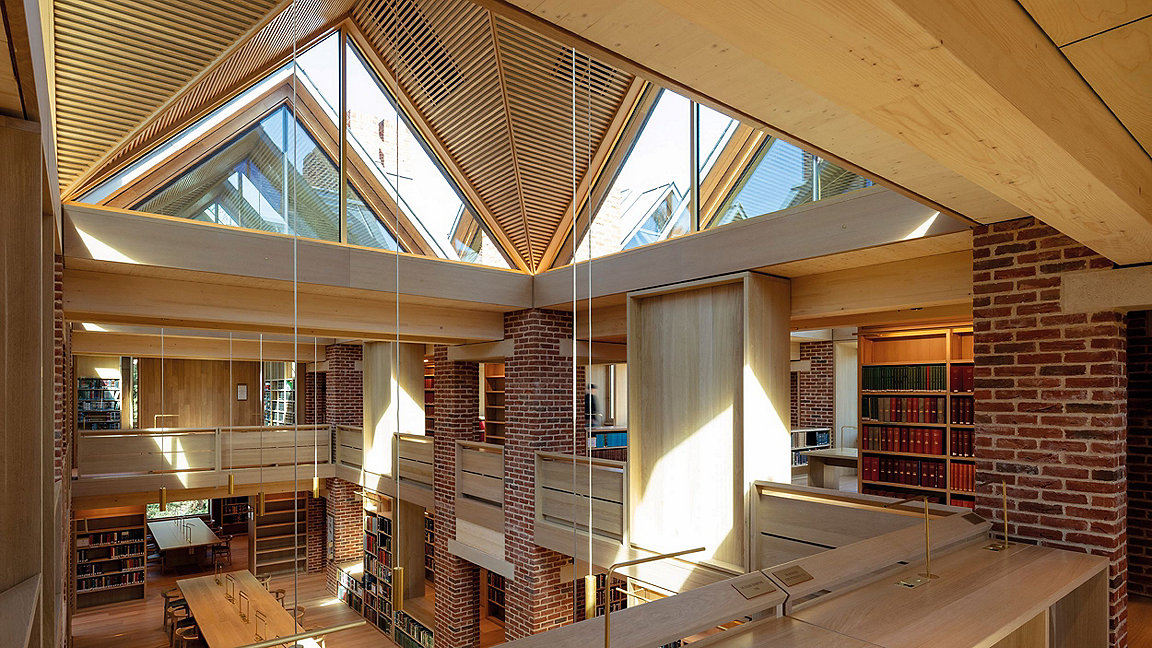
© Nick Kane
Mass timber is a generic term that encompasses products of various sizes and functions, but the most common and familiar form is cross-laminated timber (CLT).
Invented in the early 1990s by Gerhard Schickhofer, CLT soon gained popularity across Europe because it can be used to make floors, walls, ceilings and even entire buildings.
It's lighter than steel and concrete, therefore requiring fewer vehicle movements to transport to site. It's also quick to assemble, creates less dust and has lower embodied carbon; in fact, it is a natural carbon store.
However, following the Grenfell Tower fire in 2017, combustible products in the external frame of buildings more than 18m were banned in the UK by Approved Document 7, which amended the Building Regulations 2010; indeed, the Greater London Authority implemented a total ban on timber in the external frames of social housing.
Insurers favour concrete and steel by default
These factors, coupled with a hardening insurance market, meant that cover either became very expensive to procure or was simply refused. As a result, developers reverted to using steel and concrete – just after the government officially declared an ongoing climate emergency and the UK hosted COP26 in Glasgow.
Light timber-framed buildings have also come under scrutiny due to fire losses during construction – given that the fire-resisting layers are the last to be applied – and once built, as fire spreads in voids.
While the use of mass timber might make a significant contribution to meeting net-zero carbon ambitions, insurers must be agnostic and just deal with the risks presented. This highlights a weakness inherent in the Building Regulations in terms of property protection.
In the UK insurance market, life safety and property protection are essentially divorced. The former objective is generally considered in terms of ensuring evacuation before a building collapses; but historically speaking fires seldom result in collapse because concrete and steel are largely resilient to fire. These materials could therefore be considered as providing coincidental property protection.
If the move to structural timber use negates the property protection provided by steel and concrete, then only additional, voluntary measures can make up the shortfall until such time as the UK's Building Regulations are updated in response.
Without changes to the regulations, insurers may assume any fire will result in the loss of the entire building – which is not entirely unlikely for thatched buildings, but improbable for most normal building types.
Obstacles to mass timber use researched
A 2021 mass timber forum hosted by property consultancy Gardiner & Theobald demonstrated that construction and property insurance was one of the biggest challenges to overcome in scaling up the use of this construction material.
This was confirmed the following year in research by the Timber Accelerator Hub funded by Built by Nature, the latter being a network dedicated to accelerating the timber building transformation in Europe.
It became clear that construction and insurance were siloed and needed to collaborate to understand the processes and language that each other use, and most importantly to emphasise the benefits of early engagement between developers, their supply chain and their insurers.
The Alliance for Sustainable Building Products (ASBP) applied to Built by Nature to fund guidance to overcome this challenge, and risk managers Marsh and Zurich Resilience Solutions both offered money and in-kind support for the Timber Accelerator Hub report in February 2022.
Separately, insurers had, through the research scheme RISCAuthority, published a white paper in April 2022 entitled Insurance challenges of mass timber construction and a possible way forward, highlighting their concerns, clarifying their stance and laying out the key principles at stake.
Separately, fire engineering consultancy OFR Consultants, in partnership with the Structural Timber Association (STA), researched compartment fire behaviour in CLT, and published its findings recently in volume 6 of the STA's Fire safety in use guidance.
Playbook offers guidance on managing risks
The Mass timber insurance playbook published by the ASBP meanwhile provides a framework for understanding and resolving the challenges that are currently hindering insurance provision for mass timber buildings.
The playbook is authored by consultant Dr Jim Glockling and Mass Timber Risk Consulting founder Philip Callow, and endorsed by RIBA and other bodies. The project has been managed by the team at ASBP, led by myself, with support from Richard Broad who created the graphics, and input from mass timber specialist Eurban as well as Gardiner & Theobald.
Speaking at a workshop for mass timber stakeholders, Gardiner & Theobald timber specialist and partner Oliver Booth said: 'This new guidance is incredibly important. There has been a lack of understanding of how risks are mitigated by design and construction teams, which have been holding back mass-timber construction. […] Insurance is by far the biggest thing making projects stall. There are a lot of pointers in the playbook that we should be adopting on all our projects.'
The introduction explains that the playbook is written for the entire supply chain and should be used by all parties. It goes on to explain to the construction industry the resilience objectives of the insurance profession, and details the challenges that need to be addressed.
It introduces the concept of estimated maximum loss, which is used to assess potential loss caused by property damage and business interruption caused by fire or ingress of water. Indeed, two key areas for the insurer include fire spread within a building, and between buildings.
The playbook also offers guidance for everyone in the supply chain on the detail required by insurers or brokers through each of the eight RIBA stages, commencing with strategic definition in stage 0 and preparation and brief in stage 1.
It further advises on how to mitigate risk, and to demonstrate to the insurer that doing so has been a key strategy from inception. This concludes with RIBA stage 7, namely use, and should help with ongoing property insurance.
In appendix A, the playbook describes 26 building insurability features, such as combustible void protection and anticipating arson attacks, that can be used as a framework to demonstrate that risks have been considered and reduced throughout. This includes designing for escape of water and water damage limitation.
It might surprise many readers to know that some insurers consider the potential water-based insurance losses – ingress and escape – to be more worrisome than those from fire.
In the domestic and residential environment, losses from escape of water are incredibly frequent and costly, accounting for more than fire and security losses combined.
Now consider this occurring in a multi-storey mass-timber building, and you soon realise how it might exacerbate losses still further in the future.
Future projects aim to test and certify products
Built by Nature has been particularly active in supporting the advance of mass timber and funded a number of pioneering projects. These include a model six-storey residential building designed by architects Waugh Thistleton, where every detail has been approved and signed off by the National House-Building Council, and another project in which architects dRMM are examining the embodied carbon and health and well-being benefits of using mass timber in five case studies.
ASBP's next project with Built by Nature commences in September, where we shall be examining supply-chain transparency and improving the information from forest to building.
This will involve working with the Programme for the Endorsement of Forest Certification (PEFC), Double Helix Tracking Technologies, Stora Enso, Eurban and other organisations to investigate how we might overlay forest and biodiversity data on to the existing PEFC system.
The playbook is free to download and we would appreciate any feedback. You can also sign up for the ASBP's free monthly newsletter on our website, which details all our activities and research projects.

